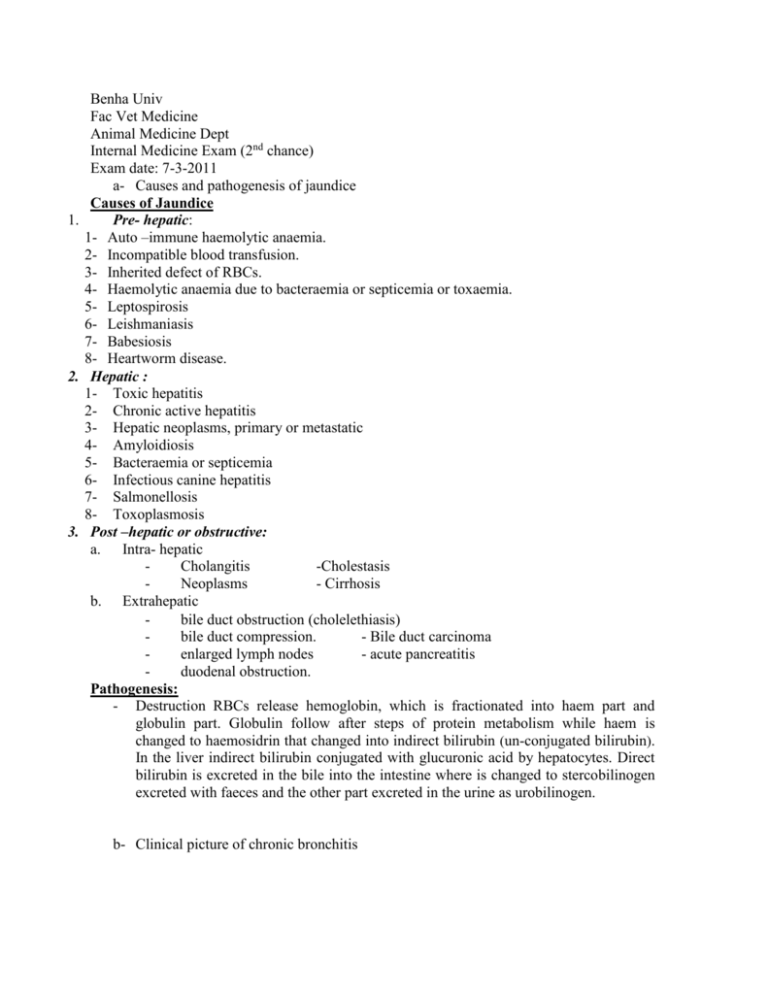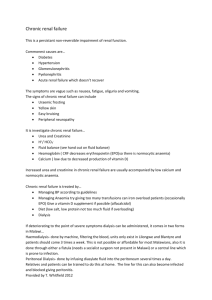1. Pre-renal failure
advertisement

Benha Univ Fac Vet Medicine Animal Medicine Dept Internal Medicine Exam (2nd chance) Exam date: 7-3-2011 a- Causes and pathogenesis of jaundice Causes of Jaundice 1. Pre- hepatic: 1- Auto –immune haemolytic anaemia. 2- Incompatible blood transfusion. 3- Inherited defect of RBCs. 4- Haemolytic anaemia due to bacteraemia or septicemia or toxaemia. 5- Leptospirosis 6- Leishmaniasis 7- Babesiosis 8- Heartworm disease. 2. Hepatic : 1- Toxic hepatitis 2- Chronic active hepatitis 3- Hepatic neoplasms, primary or metastatic 4- Amyloidiosis 5- Bacteraemia or septicemia 6- Infectious canine hepatitis 7- Salmonellosis 8- Toxoplasmosis 3. Post –hepatic or obstructive: a. Intra- hepatic Cholangitis -Cholestasis Neoplasms - Cirrhosis b. Extrahepatic bile duct obstruction cholelethiasis bile duct compression. - Bile duct carcinoma enlarged lymph nodes - acute pancreatitis duodenal obstruction. Pathogenesis: - Destruction RBCs release hemoglobin, which is fractionated into haem part and globulin part. Globulin follow after steps of protein metabolism while haem is changed to haemosidrin that changed into indirect bilirubin un-conjugated bilirubin. In the liver indirect bilirubin conjugated with glucuronic acid by hepatocytes. Direct bilirubin is excreted in the bile into the intestine where is changed to stercobilinogen excreted with faeces and the other part excreted in the urine as urobilinogen. b- Clinical picture of chronic bronchitis It is disease of adult dogs, less common to be seen in dogs less than 3-5 years. 1. Insidious onset of chronic intractable cough persistent cough 2. The dogs had been treated before several times. 3. The cough is unproductive, dry, harsh and hacking. It is easily induced by tracheal pressure, excitement or exercise. 4. The cough may occur as bouts of paroxysms. 5. Temperature is normal. 6. Lung sounds may vary according to the degree of obstruction. It may be normal vesicular or pan inspiratory coarse crackles or polyphonic expiratory wheeze. 7. The cough may be moist and at morning only follows by retching. 8. Lethargy fever and inappetance may indicate bacterial infection. IIa- Diagnosis of renal failure 1. Pre-renal failure: This condition is usually due to some affection that results in an inadequate blood pressure in the renal artery as in cases of shock, dehydration; and some cardiac diseases. 2. Primary renal failure: This condition is due to affection of the kidney tissue either by inflammatory process, infection, neoplasm’s or calculi. 3. Post –renal failure: This condition is due to inadequate flow of the concentrated urine in the urinary tract as in cases of obstruction or rupture of the bladder and/or urethra. Renal failure may be acute of chronic. Both acute and chronic renal failure was terminated in uremia. Acute renal failure, although very dangerous, is curable chronic renal failure is very dangerous an incurable. Clinical symptoms: 1. The case usually occurs in old aged dogs and cats. 2. It may occur after surgical operations or heavy wasting disease affection. At the early stages the animal dog or cat shows signs of dullness somnolence, anorexia or inappetance; and muscular weakness. 3. Rapid rate of respiration; and may be some muscular tremors may appear after. 4. Vomition, severe stomatitis, respiratory distress, anurea, sever urinephrous odour from the mouth, severe oedema, muscular convulsions, or fibrillar muscle contraction, profuse urinephrous sweating, inflammatory skin affection, complete recumbency, diarrheoa, contracted eye pup and finally end in coma. Laboratory findings: The blood picture revealed decreased level of hemoglobin and red blood corpuscles. Very high blood urea level up to 500mg% and plasma creatinine levels up to 19 or 25 mg %. The serum level of potassium, carbonate; and chlorine are elevated markedly. While the sodium level showed somewhat lowered direction. b- Treatment of eczema Nasalis c- Keep the dog away from sunlight. d- Use antibiotic corticosteroid ointment. It must be applied at all the season when application ceased symptoms reapear again. e.g. Terracortile ointment. Lutacortin ointment and terramycine ointment. Tetracort. R/Metimyd oint: with neomycine. Each 1/8 O2 tube contain. Prednisolone acetate 5mg Sodium sulfacetamide 100mg Neomycine sulfate 2.5 mg To be rubbed on clean skin. III- diabetes mellitus Definition: Diabetes mellitus is a chronic complex disorder of carbohydrate, fat and protein metabolism, which results from an inability to produce adequate amounts of insulin i.e. due to insulin deficiency characterized by polyuria, polydipsia, and polyphagia Etiology: 1- Destruction (damage) of beta cells of Islet of Langerhans 1- Following diseases of pancreatic parenchyma for example pancereatitis, pancreatic atrophy or fibrosis (most cases), neoplasia or trauma (occasionally). 2- Genetic factors: a- Mutation in the insulin structure which render the hormone inactive. b- Mutations that cause defect in the conversion of preproinsulin or preinsulin to the active hormone. 3- Idiopathic reduction in the number of beta cells and even the disappearance of many of the islets. 4- Aplasia of the islets in young puppies (ra Types of diabetes mellitus 1- Type-I D.M.: insulin-dependent DM (called also juvenile DM because of its early onset) which results from deficiency of insulin. 2- Type-II D.M.: insulin-resistant DM. the patient cannot respond to the insulin therapy because of a defect in the cellular uptake of the glucose (defect in transporter for example) Clinical signs: 1- The onset of D.M. is insidious. 2- Polyuria and polydipsia are the prime clinical signs. 3- Polyphagia is often present. 4- Bilateral cataract (opacity of lens), corneal opacity and retinopathy. 5- Weight loss and emaciation (due to muscle wasting). 6- Digestive disorder if pancreatic parenchyma has been damaged particulary due to pancreatitis. 7- In the terminal ketoacidotic stage (blood acidosis phase) there are: a) Acetone odour may be detected on the breath. b) Neuropathy due to direct toxic effect of ketogenic acids on CNS. c) Inappetance, .increased rate and depth of breathing, vomiting (2-3 times per 48 hours). d) Severe dehydration (may lead to acute renal failure) and listlessness e) The terminal episode is diabetic coma and death. Diagnosis: A) History. (B) Clinical signs. C ) Lab. Diagnosis. a- Determination of fasting blood sugar: -In fasting canines, blood sugar level above 120-130 mg% is diganostic of D.M. (normal 60-100 mg %). -Values sometimes as high as 500 mg% in the disease. b-Detection of fasting glucosuria: - The renal threshold for glucose in the dog lies between 175 and 220 mg% and usually when blood glucose level exceeds 180 ig% glucose is not completely reabsorbed from the renal Tubules resulting in glucosuria in D.M. Treatment: - Success in treatment depend on the under standing and cooperation of the owner. a- Mild diabetes mellitus: 1-Reduction of carbohydrate intake is sufficient to control hyperglycaemia and gluosuria i.e, control by change to semidiabetic diet. 2- If the dog is obese reduce fat intake additionally i.e. protein and low in carbohydrate is advocated, consisting of approximately 80% meat and 20% carbohydrate (rice or biscuit) and fed at rate of 30 gm /kg b.wt. / day. b- Moderate diabetes mellitus: In addition to the previous diet restriction, an oral hypoglycaemic drug to - stimulate insulin secretion may be needed for example: 1- Sulphonyluras (most commonly employed). 2- Tolbutamide (but markedly hepatotoxic in the dog). 3- chloropamide (preferable to use) B- diseases causing change in feces 1- Enteritis 2- Megacolon 3- Constipation 4- Gastritis 5- Anal succulitis







